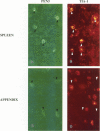Abstract
PEN5 is a carbohydrate epitope selectively expressed on peripheral blood natural killer cells. We have used a monoclonal antibody reactive with PEN5 to survey the expression of PEN5+ large granule lymphocytes in a variety of human tissues. PEN5+ cells are scattered throughout lymphoid (eg, lymph node, tonsil, thymus, spleen, and intestine) and nonlymphoid (eg, liver, esophagus, lung, and uterus) organs. Due to their relatively abundant cytoplasm, these cells are somewhat larger than resting tissue lymphocytes. The majority of splenic (87 +/- 13%, n = 5) and hepatic (92 +/- 6%, n = 5) PEN5+ lymphocytes coexpress TIA-1, a cytotoxic granule protein found in natural killer cells. In some tissues (eg, tonsil and Peyer's patch), however, relatively few PEN5+ lymphocytes coexpress TIA-1, possibly reflecting different stages of activation or differentiation. Our results indicate that PEN5 may be a useful marker of tissue-infiltrating natural killer cells and reveal these cells to be surprisingly abundant in lymphoid tissues.
Full text
PDF
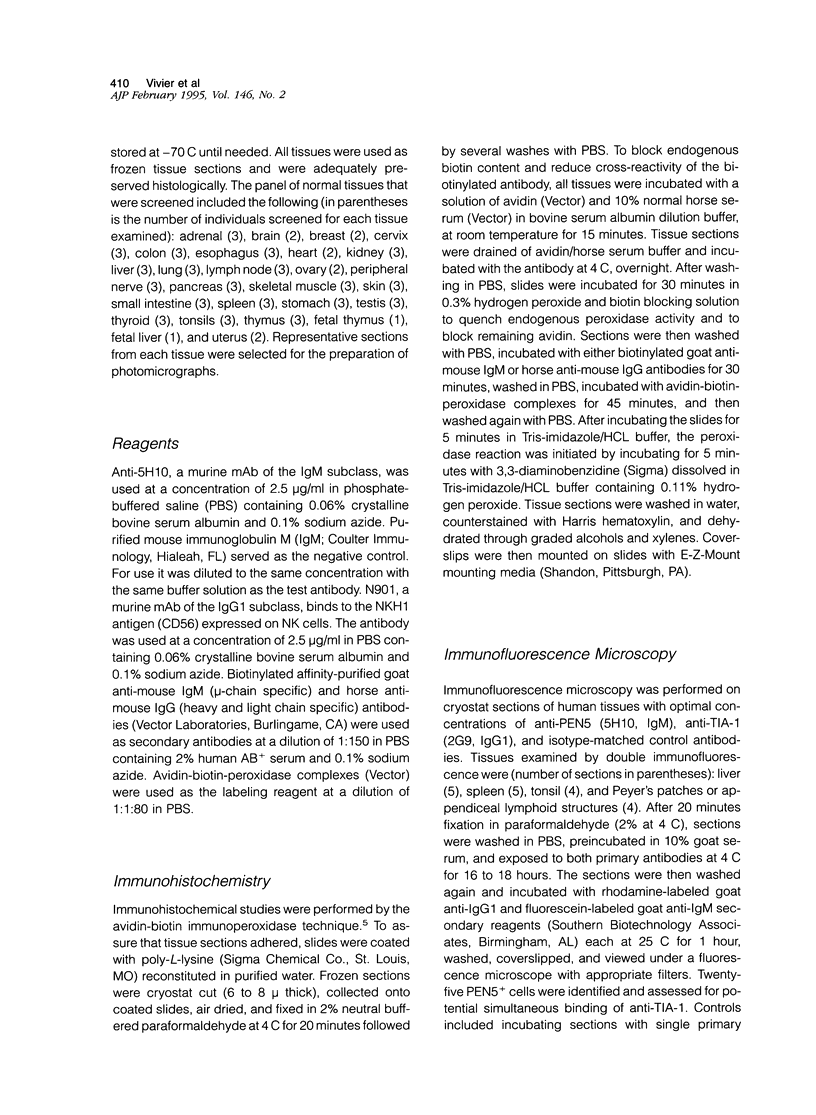
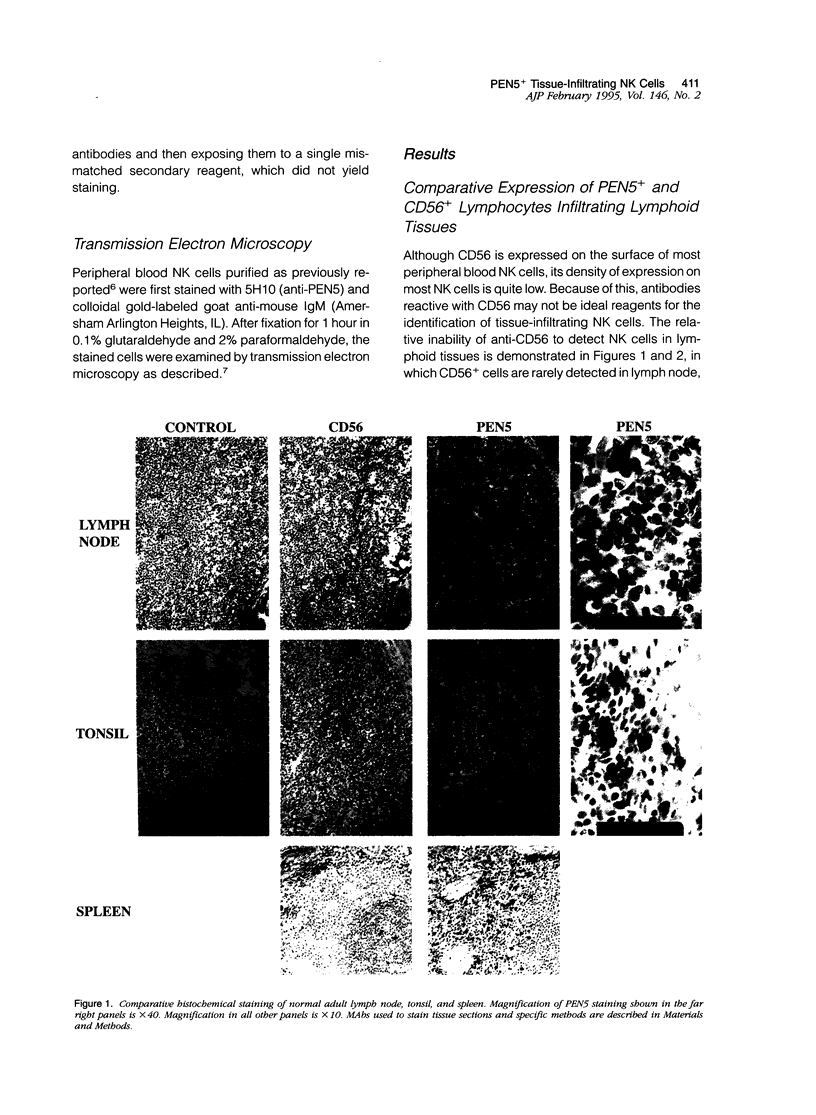
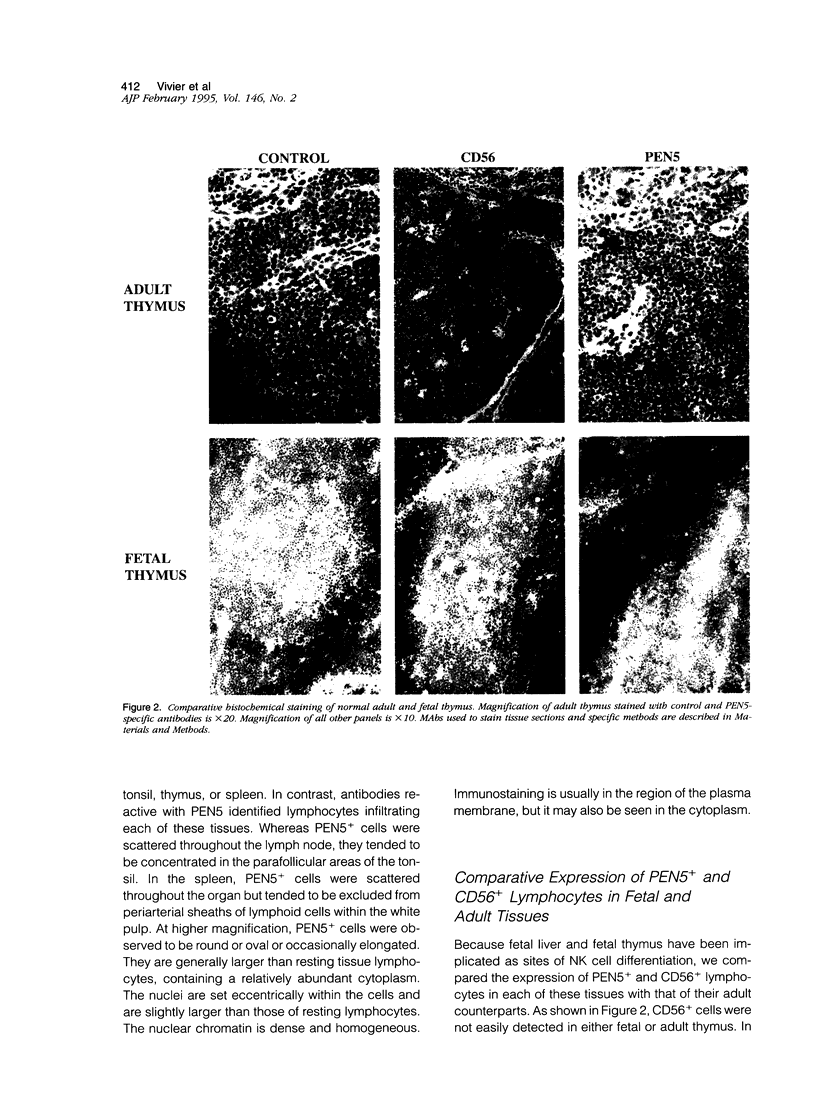
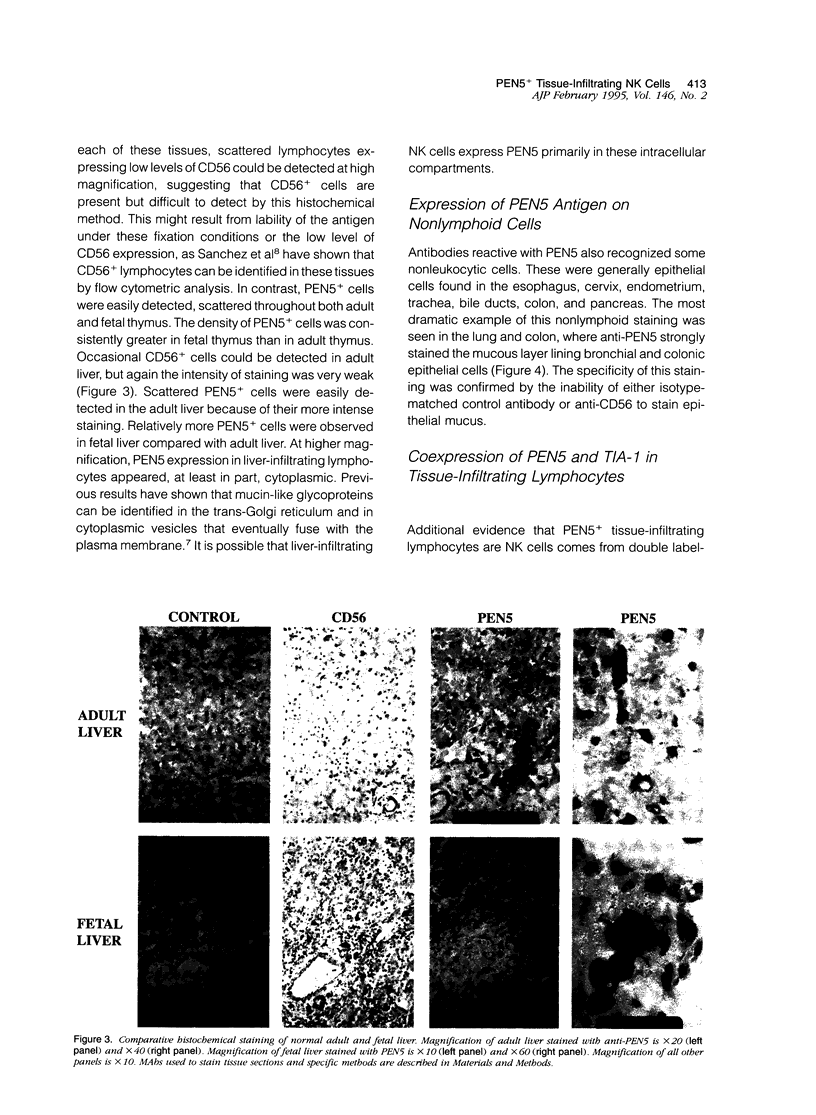

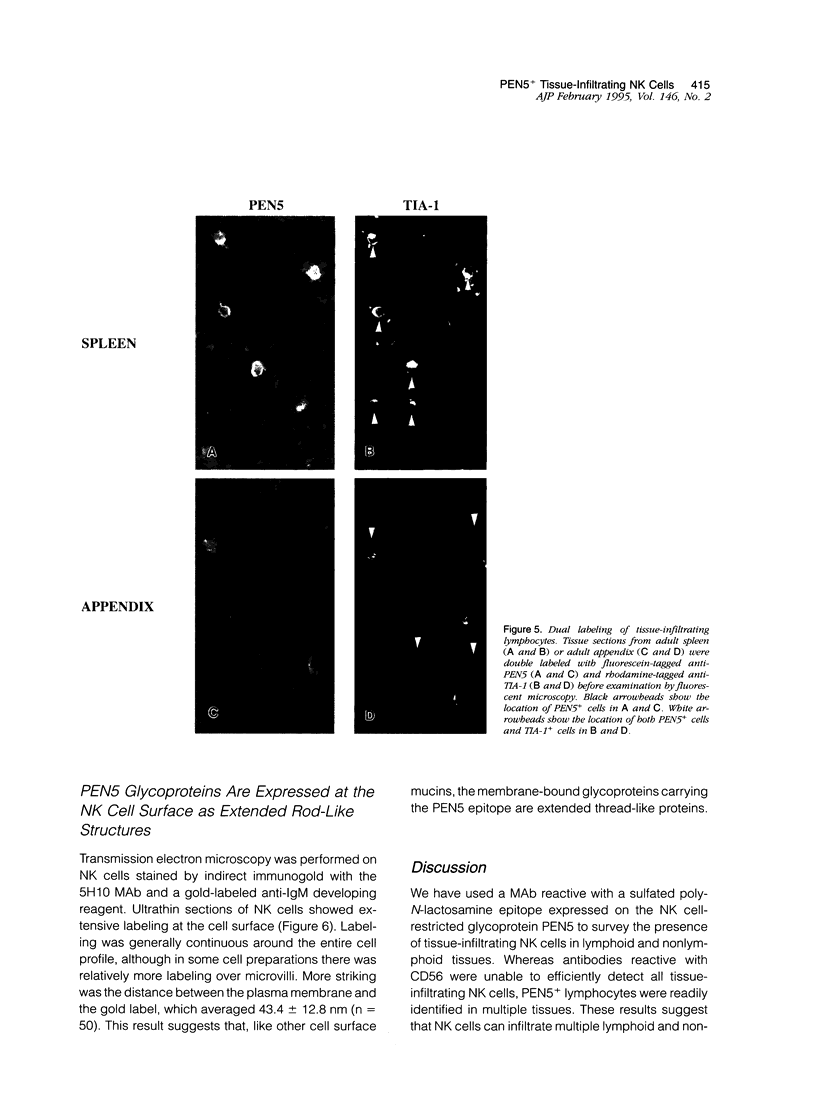
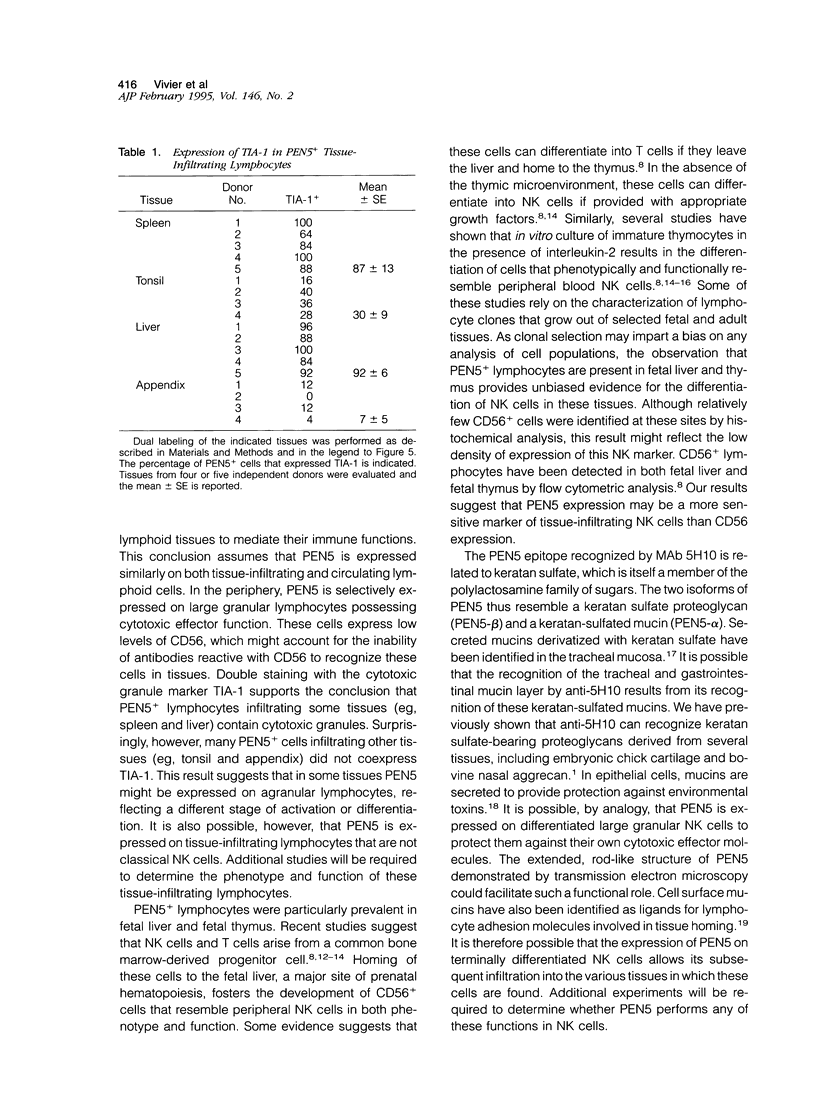
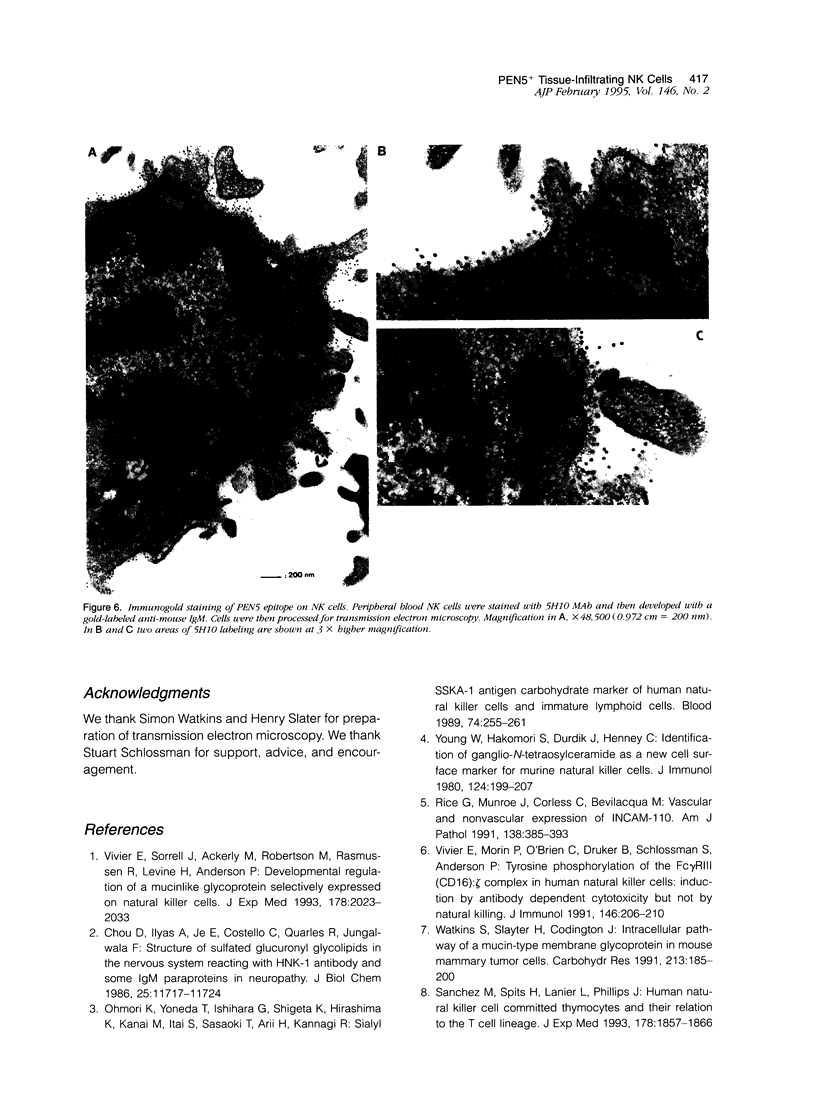
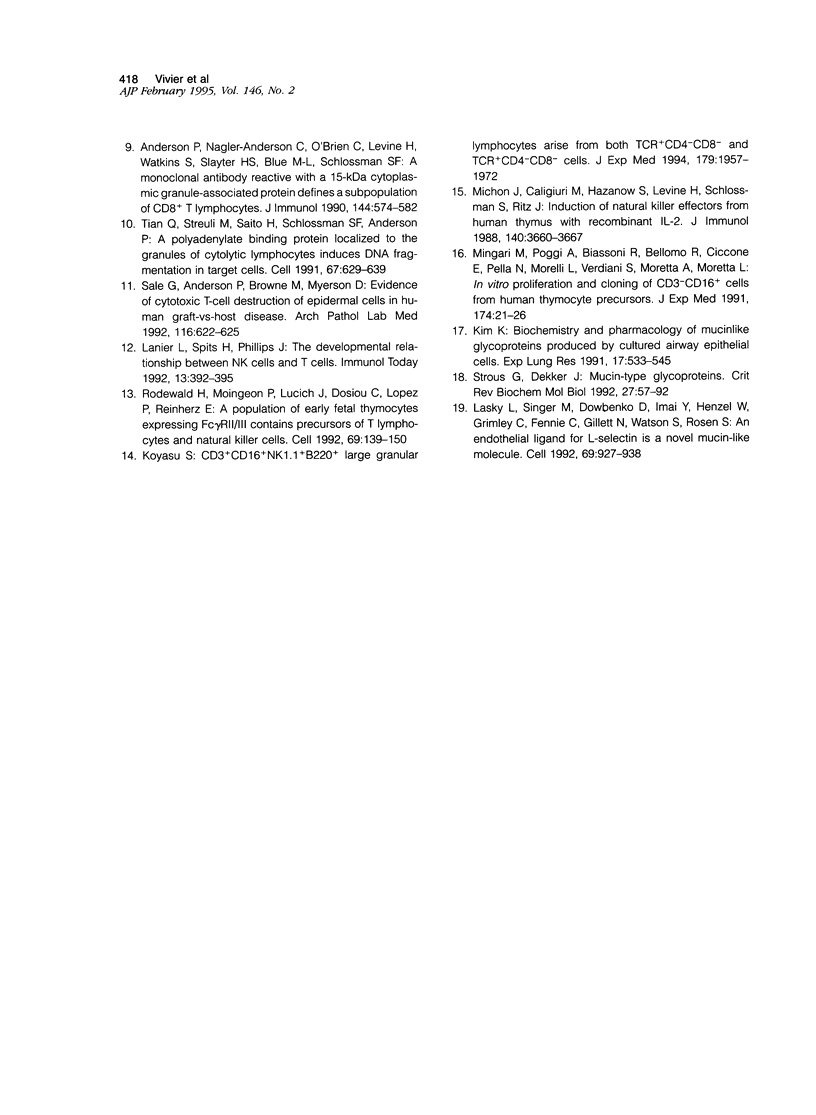
Images in this article
Selected References
These references are in PubMed. This may not be the complete list of references from this article.
- Anderson P., Nagler-Anderson C., O'Brien C., Levine H., Watkins S., Slayter H. S., Blue M. L., Schlossman S. F. A monoclonal antibody reactive with a 15-kDa cytoplasmic granule-associated protein defines a subpopulation of CD8+ T lymphocytes. J Immunol. 1990 Jan 15;144(2):574–582. [PubMed] [Google Scholar]
- Chou D. K., Ilyas A. A., Evans J. E., Costello C., Quarles R. H., Jungalwala F. B. Structure of sulfated glucuronyl glycolipids in the nervous system reacting with HNK-1 antibody and some IgM paraproteins in neuropathy. J Biol Chem. 1986 Sep 5;261(25):11717–11725. [PubMed] [Google Scholar]
- Kim K. C. Biochemistry and pharmacology of mucin-like glycoproteins produced by cultured airway epithelial cells. Exp Lung Res. 1991 May-Jun;17(3):533–545. doi: 10.3109/01902149109062863. [DOI] [PubMed] [Google Scholar]
- Koyasu S. CD3+CD16+NK1.1+B220+ large granular lymphocytes arise from both alpha-beta TCR+CD4-CD8- and gamma-delta TCR+CD4-CD8- cells. J Exp Med. 1994 Jun 1;179(6):1957–1972. doi: 10.1084/jem.179.6.1957. [DOI] [PMC free article] [PubMed] [Google Scholar]
- Lanier L. L., Spits H., Phillips J. H. The developmental relationship between NK cells and T cells. Immunol Today. 1992 Oct;13(10):392–395. doi: 10.1016/0167-5699(92)90087-N. [DOI] [PubMed] [Google Scholar]
- Lasky L. A., Singer M. S., Dowbenko D., Imai Y., Henzel W. J., Grimley C., Fennie C., Gillett N., Watson S. R., Rosen S. D. An endothelial ligand for L-selectin is a novel mucin-like molecule. Cell. 1992 Jun 12;69(6):927–938. doi: 10.1016/0092-8674(92)90612-g. [DOI] [PubMed] [Google Scholar]
- Michon J. M., Caligiuri M. A., Hazanow S. M., Levine H., Schlossman S. F., Ritz J. Induction of natural killer effectors from human thymus with recombinant IL-2. J Immunol. 1988 May 15;140(10):3660–3667. [PubMed] [Google Scholar]
- Mingari M. C., Poggi A., Biassoni R., Bellomo R., Ciccone E., Pella N., Morelli L., Verdiani S., Moretta A., Moretta L. In vitro proliferation and cloning of CD3- CD16+ cells from human thymocyte precursors. J Exp Med. 1991 Jul 1;174(1):21–26. doi: 10.1084/jem.174.1.21. [DOI] [PMC free article] [PubMed] [Google Scholar]
- Ohmori K., Yoneda T., Ishihara G., Shigeta K., Hirashima K., Kanai M., Itai S., Sasaoki T., Arii S., Arita H. Sialyl SSEA-1 antigen as a carbohydrate marker of human natural killer cells and immature lymphoid cells. Blood. 1989 Jul;74(1):255–261. [PubMed] [Google Scholar]
- Rice G. E., Munro J. M., Corless C., Bevilacqua M. P. Vascular and nonvascular expression of INCAM-110. A target for mononuclear leukocyte adhesion in normal and inflamed human tissues. Am J Pathol. 1991 Feb;138(2):385–393. [PMC free article] [PubMed] [Google Scholar]
- Rodewald H. R., Moingeon P., Lucich J. L., Dosiou C., Lopez P., Reinherz E. L. A population of early fetal thymocytes expressing Fc gamma RII/III contains precursors of T lymphocytes and natural killer cells. Cell. 1992 Apr 3;69(1):139–150. doi: 10.1016/0092-8674(92)90125-v. [DOI] [PubMed] [Google Scholar]
- Sale G. E., Anderson P., Browne M., Myerson D. Evidence of cytotoxic T-cell destruction of epidermal cells in human graft-vs-host disease. Immunohistology with monoclonal antibody TIA-1. Arch Pathol Lab Med. 1992 Jun;116(6):622–625. [PubMed] [Google Scholar]
- Strous G. J., Dekker J. Mucin-type glycoproteins. Crit Rev Biochem Mol Biol. 1992;27(1-2):57–92. doi: 10.3109/10409239209082559. [DOI] [PubMed] [Google Scholar]
- Sánchez M. J., Spits H., Lanier L. L., Phillips J. H. Human natural killer cell committed thymocytes and their relation to the T cell lineage. J Exp Med. 1993 Dec 1;178(6):1857–1866. doi: 10.1084/jem.178.6.1857. [DOI] [PMC free article] [PubMed] [Google Scholar]
- Tian Q., Streuli M., Saito H., Schlossman S. F., Anderson P. A polyadenylate binding protein localized to the granules of cytolytic lymphocytes induces DNA fragmentation in target cells. Cell. 1991 Nov 1;67(3):629–639. doi: 10.1016/0092-8674(91)90536-8. [DOI] [PubMed] [Google Scholar]
- Vivier E., Morin P., O'Brien C., Druker B., Schlossman S. F., Anderson P. Tyrosine phosphorylation of the Fc gamma RIII(CD16): zeta complex in human natural killer cells. Induction by antibody-dependent cytotoxicity but not by natural killing. J Immunol. 1991 Jan 1;146(1):206–210. [PubMed] [Google Scholar]
- Vivier E., Sorrell J. M., Ackerly M., Robertson M. J., Rasmussen R. A., Levine H., Anderson P. Developmental regulation of a mucinlike glycoprotein selectively expressed on natural killer cells. J Exp Med. 1993 Dec 1;178(6):2023–2033. doi: 10.1084/jem.178.6.2023. [DOI] [PMC free article] [PubMed] [Google Scholar]
- Watkins S. C., Slayter H. S., Codington J. F. Intracellular pathway of a mucin-type membrane glycoprotein in mouse mammary tumor cells. Carbohydr Res. 1991 Jun 25;213:185–200. doi: 10.1016/s0008-6215(00)90608-6. [DOI] [PubMed] [Google Scholar]
- Young W. W., Jr, Hakomori S. I., Durdik J. M., Henney C. S. Identification of ganglio-N-tetraosylceramide as a new cell surface marker for murine natural killer (NK) cells. J Immunol. 1980 Jan;124(1):199–201. [PubMed] [Google Scholar]







